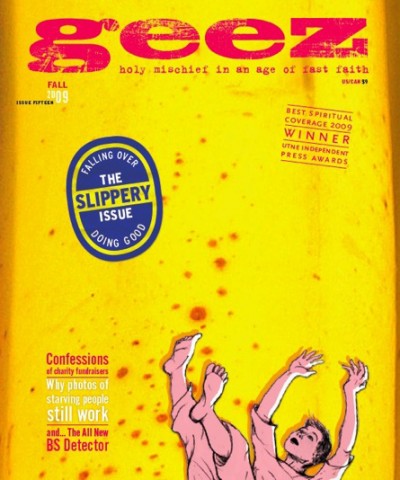Changing the story of change
The essence of the New Monasticism movement is articulated by and for people like me, not for single welfare moms. The model envisioned by members of the movement is of God sending a prophet to the suburbs to mobilize a great social movement, whereas in the Gospels, Jesus seems to head to the equivalent of battered women’s shelters, gay pride rallies and drug corners to mobilize his movement. That’s where it begins.
Shante’s tears are beginning to break through. Again. For the third time this week she’s telling a visiting youth group that her father raped her when she was 12. She’s telling them, with no less pain than any of the other times, that she began drinking heavily at 14 and picked up crack cocaine at 19. As her tears burst through, Shante (not her real name) is describing her long road to recovery and wholeness. A couple of the kids listen attentively. Three are sleeping. One is texting a crush back in suburban Massachusetts. The youth minister who brought the kids to North Central Philadelphia on this “mission trip” is also crying – her sister died of a heroin overdose three years ago.
Sitting in the back of the room, I’m beginning to get pissed off. Hosting visiting groups to New Jerusalem Now, a grassroots addiction treatment community in North Philly, is starting to feel like poverty tourism. The purpose of the day’s activities is to give the youth group an experience that will hopefully inspire them to care about “the poor.” I think that’s what ignites my anger – Shante should be the most important person in this little gathering, but she’s not. She’s a means to an end, the end being to inspire young, white, suburban Christian youth to be more conscious of poverty. They’re the most important people in the gathering; the day’s events are more about them than the people who live in the recovery community they’re visiting. The privileged suburban kids are at the centre of the narrative.
That’s when it hits me – I am one of those kids, another member of the middle-class, social justice-oriented segment of Christianity that sees itself at the core of God’s activity in the world. The ideas I have consumed and produced, and the activities I have involved myself in, all tend to put privileged people centre stage.
This dynamic also plays out in School(s) for Conversion: 12 Marks of a New Monasticism, a book that emerged from the New Monasticism movement which brings together commitment to communal life and care for marginalized people. The first three of the 12 marks make the point about privilege.
The first mark is “Relocation to the abandoned places of Empire.” But if you’re from the ghetto, you can’t “relocate” there. So the starting point is a privileged location. Second, “Sharing economic resources with fellow community members and the needy among us.” The needy aren’t “us.” The community isn’t made up of the needy but rather the people who organize themselves to serve the needy. The third mark is “Hospitality to the stranger.” Again, the way it is explained in the book, the stranger, wanderer, homeless is the other, but not the protagonist in the story.
The 12 marks lead us to a radical lifestyle, but at a closer reading, they assume privilege. Their audience is middle-class Christians, and their language decidedly leaves poor people somewhere other than at the core of the community. It’s appropriate for privileged people of conscience to figure out how we should live, but the problem is that we always end up at the centre of the story.
The essence of the New Monasticism movement is articulated by and for people like me, not for single welfare moms. The model envisioned by members of the movement is of God sending a prophet to the suburbs to mobilize a great social movement, whereas in the Gospels, Jesus seems to head to the equivalent of battered women’s shelters, gay pride rallies and drug corners to mobilize his movement. That’s where it begins.
Maybe the 12 marks need a new look. I’m tempted to create 12 poor-centric marks that exclude persons of privilege just so we can see what it feels like. Instead, I’ll highlight three examples of an alternative model.
First, in India, Gandhi organized farmers, peasants and labourers, the very people who were being oppressed. He sought to upend the caste system from the bottom up.
Second, Martin Luther King Jr.‘s work with the Southern Christian Leadership Conference involved organizing southern black churches to resist, march and boycott the various evils they faced directly. The movement started on the margins.
Third, in L’Arche communities, people with and without disabilities live together in households. The people with disabilities are called “core members,” and the households are centered around them, not the assistants.
These examples mirror Jesus’ approach. His message tended to be for and about the disenfranchised, and he seems to have spent the majority of his time with these people.
As privileged people, we need to be willing to give up the spotlight and move ourselves out of the centre of the stories we are living in, lest we begin to think that the most important people in the story are ourselves.
Nate Buchanan lives in the Germantown section of Philadelphia. He can be reached at averydewitt@mail.com.
Note: We will invite the authors of 12 Marks of a New Monasticism to respond to this article in the next issue of Geez. - Eds.



Sorry, comments are closed.